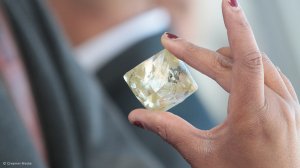Anglo’s De Beers empowers diamond trading business in R2.5bn deal



DBCM executive chairperson Barend Petersen
Photo by Duane Daws
Photo by Duane Daws
KIMBERLEY (miningweekly.com) – Anglo American group company De Beers on Tuesday empowered its South African diamond trading business in a deal with the black-controlled Ponahalo Holdings.
Ponahalo, which bought 26% of De Beers Consolidated Mines (DBCM) eight years ago, has now acquired 26% of De Beers Sightholder Sales South Africa in a R2.5-billion deal that will be funded from cash flow.
DBCM executive chairperson Barend Petersen said the deal had been eight years in the making, the delay being the result of the decline of the global diamond market in the wake of the 2008 global financial crisis and the decision of Ponahalo to also be part of the R20-billion investment in the Venetia diamond mine underground project.
The latest deal makes Ponahalo part of De Beers’ diamond sorting and valuation business, enabling the diamond company to fulfil its Mining Charter commitment to black economically empower both mining and marketing.
DBCM produces five-million carats a year, which is all sorted and valued in Kimberley, South Africa’s rough diamond trading centre where the company holds ten diamond sales a year.
By value, 40% of the diamonds are supplied to South African diamond cutting and polishing factories.
Quizzed on Ponahalo’s returns thus far, Petersen told Mining Weekly Online that at the end of 2013 the empowerment company received a real value return for all of its stakeholders.
“I would say that our returns so far have been sparkling. We don’t look at this asset only from a cash perspective but from a value perspective and, of course, going forward the appreciation of the asset will continue to grow.
“Because we are funding the investment of Venetia, there’s not going to be short-term cash benefits, but going forward, the value of Ponahalo in terms of the equity of last year and the growth projections, I do believe this is a significant growth opportunity for all our stakeholders, including our employee base, which is very much part of the transaction,” Petersen said.
Ponahalo has 15 000 shareholders in the employee scheme as well as three trusts, one benefiting disabled people, the second benefitting previously disadvantaged women and the third a community trust.
“There are huge numbers of people benefiting from our expenditure in the trusts and we will continue with our projects through those trusts,” DBCM CEO Phillip Barton told Mining Weekly Online.
Petersen anticipated that an acceleration of redemption of Ponahalo debt in the next few years would result in more direct benefits being available to the beneficiaries.
“Ponahalo was under water sometime ago and we looked at a range of solutions to make Ponahalo financially sustainable with value for our employees.
“That’s why we could report that even last year there was serious value from Ponahalo and this new transaction has now contributed to even more value to the employees,” Petersen said.
The bulk of the R20-billion that would be invested in the Venetia underground project between now and 2021 would be self-funding.
“That’s the first call of our funds and the investment by De Beers together with Ponahalo demonstrates our trust in the diamond business and our belief that the value will be there,” said Barton.
The transaction has taken place at a time of growing diamond jewellery demand, which rose 7% in the US last year.
“There is reason to be optimistic about diamond demand continuing,” Petersen commented.
Diamond consumption is also continuing to rise in China.
De Beers Sightholder Sales South Africa, which is mandated by the De Beers Group to deliver on beneficiation, established the Kimberley Internal Diamond and Jewellery Academy three years ago, which focuses on providing training to learners across the country, in diamond cutting and polishing.
Working in partnership with the Northern Cape government, the academy has produced 145 graduates, 98% being historically disadvantaged South Africans and 24 of them being learners with disabilities.
The extension of broad-based empowerment within the company brings employees and community trusts into the shareholding and deepens DBCM’s partnership with Ponahalo by taking the relationship into the realm of diamond marketing.
Ponahalo chairperson Manne Dipico, former Northern Cape premier and ex-De Beers employee and union leader, said 50% of the 26% empowerment shareholding belonged to the workers and the former workers of DBCM and now also including the 185 workers of De Beers Sightholder Sales South Africa.
“This is not a transaction of individuals grabbing money and running away and the workers are the biggest shareholders and they can overrule the chair, they can overrule everybody because they are such a significant part,” Dipico said.
Of the remaining 50%, 45% belonged to the communities where the mines and operations were located.
“The individuals are nothing compared to the balance. When we talk of broadness, we have done the right thing. First and foremost we have to ensure that the benefits go down to the real beneficiaries,” he added.
The empowerment of the trading business has been eight years in the making.
“Together we must have the patience to grow the value of Ponahalo as we have been growing it for the past eight years by putting more resources into the R20-billion Venetia underground project and to have a bigger impact.
“Previous workers will tell you they got something from being shareholders, but not enough. We believe in the longevity of the mine and that there will be greater value and the children and grandchildren will be better off tomorrow.
“We have been part of mining and now we are part of the sales and Ponahalo has taken the money that has come in and reinvested it in the people.
“We have put R28-million in the operations right now to make sure that disabled people benefit and we have been investing in education, health and entrepreneurship,” Dipico said.
Forty million rand has been invested in a new abalone enterprise in Namaqualand, which is employing retrained former mineworkers.
“We have confidence in the diamond industry and that’s why we are putting money into Venetia to grow it and that we will be able, slowly but surely, to improve the lot of our employees and the communities where we operate our mines,” Dipico added.
Department of Mineral Resources deputy director general Joel Raphela said the discovery of diamonds in Kimberley and gold on the Witwatersrand more than 100 years ago had made the discoverers extremely wealthy.
“This growth and development was undeniably linked to the few and did not benefit the majority of our people. Over the past 20 years, government has consciously and consistently sought to implement national policies to reverse this trend, with many laws drafted with this intention in mind.
“The Mineral and Petroleum Resources Development Act (MPRDA) goes a step further and vests custodianship of the mineral wealth of this country in the State’s hands on behalf of its people.
“As a department, we therefore have a responsibility to ensure that we don’t just talk about transformation and how imperative it is but that it becomes a reality and that our people can see a tangible difference in their lives as a result of the MPRDA’s implementation.
“While it was premature to address details of the Mining Charter, it is worth reiterating its importance and government intends to see that it is implemented fully by the stakeholders,” Raphela said.
Established in 1888, De Beers is the world’s leading diamond company by value, supplying 35% of the world’s rough diamonds from mines in Botswana, Namibia and Canada.
It is involved in all aspects of the diamond value chain – from exploration to mining; rough diamond sales; cutting, polishing and manufacturing; and marketing.
For decades, De Beers was controlled by successive generations of South Africa’s Oppenheimer family, which several years ago sold its 40% stake to Anglo American for $5.2-billion, raising the latter’s shareholding to 85%.
Anglo American was able to take over De Beers comprehensively after the government of diamond-rich Botswana, which owns 5% of De Beers, agreed to forego its right to buy another 25%.
De Beers recovered 31.3-million carats during the year to December 31, 2011.
While this figure represented a decline from the 2010 production figure of 33-million carats, the company says this was in line with demand from sightholders.
With the South African DBCM producing five-million diamond carats a year, Ponahalo will have a hand in the sales of just over a quarter of the South African carats sold, which represents about 4% of total De Beers carats sold globally.
Comments
Press Office
Announcements
What's On
Subscribe to improve your user experience...
Option 1 (equivalent of R125 a month):
Receive a weekly copy of Creamer Media's Engineering News & Mining Weekly magazine
(print copy for those in South Africa and e-magazine for those outside of South Africa)
Receive daily email newsletters
Access to full search results
Access archive of magazine back copies
Access to Projects in Progress
Access to ONE Research Report of your choice in PDF format
Option 2 (equivalent of R375 a month):
All benefits from Option 1
PLUS
Access to Creamer Media's Research Channel Africa for ALL Research Reports, in PDF format, on various industrial and mining sectors
including Electricity; Water; Energy Transition; Hydrogen; Roads, Rail and Ports; Coal; Gold; Platinum; Battery Metals; etc.
Already a subscriber?
Forgotten your password?
Receive weekly copy of Creamer Media's Engineering News & Mining Weekly magazine (print copy for those in South Africa and e-magazine for those outside of South Africa)
➕
Recieve daily email newsletters
➕
Access to full search results
➕
Access archive of magazine back copies
➕
Access to Projects in Progress
➕
Access to ONE Research Report of your choice in PDF format
RESEARCH CHANNEL AFRICA
R4500 (equivalent of R375 a month)
SUBSCRIBEAll benefits from Option 1
➕
Access to Creamer Media's Research Channel Africa for ALL Research Reports on various industrial and mining sectors, in PDF format, including on:
Electricity
➕
Water
➕
Energy Transition
➕
Hydrogen
➕
Roads, Rail and Ports
➕
Coal
➕
Gold
➕
Platinum
➕
Battery Metals
➕
etc.
Receive all benefits from Option 1 or Option 2 delivered to numerous people at your company
➕
Multiple User names and Passwords for simultaneous log-ins
➕
Intranet integration access to all in your organisation




















